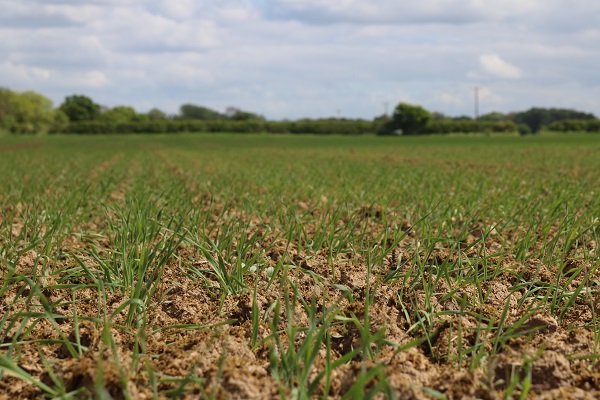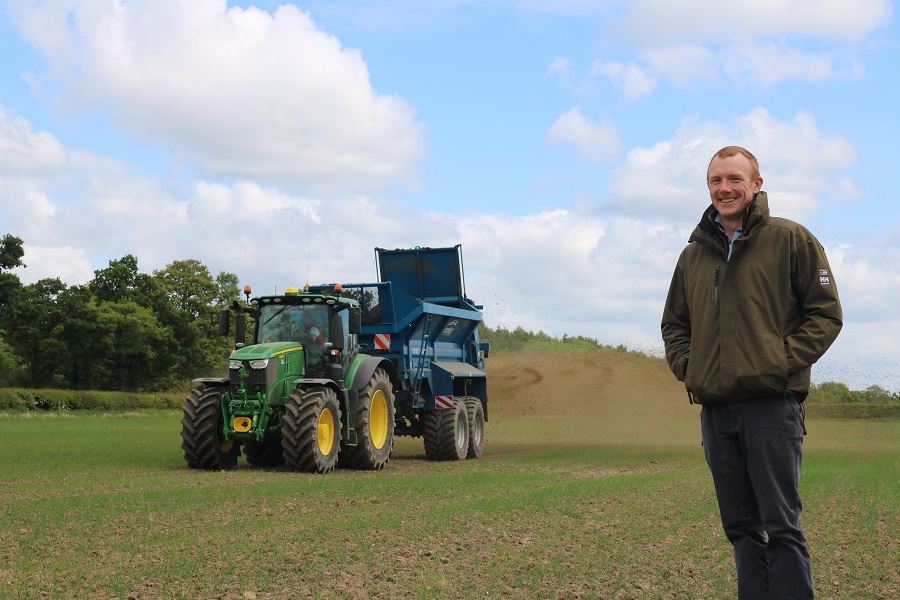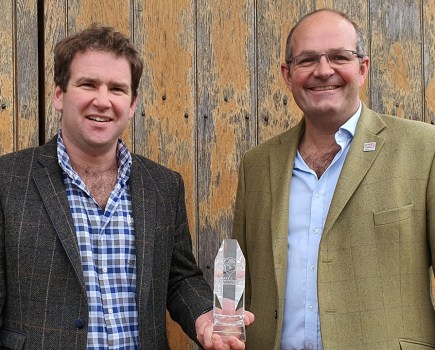Grosvenor Farms in Cheshire has already made impressive progress towards reducing carbon emissions. CPM visits to find out how building the relationship between soil health and crop nutrition is bringing multiple benefits.
With the technology we have today, the way we can use the soil is changing.
By Tom Allen-Stevens
As the Bunning 230 HBD manure spreader makes its way slowly down the field of spring-sown triticale and vetch, Charlie Steer retreats to a safe distance.
“We’re expecting a 30t/ha output of forage from this crop and only putting 120kgN/ha into it, provided entirely by manure from our own dairy unit – that’s got to be efficient, however you measure it,” he says.
The crop is being tried for the first time across 220ha of Grosvenor Farms, based at Aldford, near Chester, following a recommendation from SRUC as part of a carbon audit of the business. Charlie is arable manager, responsible for cropping over 2340ha of an estate that totals 6000ha. The crops dovetail into the farm’s dairy enterprise, that’s been recently consolidated into one unit from its previous four, milking 2500 cows three times a day through a 60-point rotary unit.

The spring triticale and vetch is expected to yield 30t/ha whole crop from a nitrogen input of just 120kgN/ha, supplied through manure.
“That’s around 84,000 litres of milk a day that goes to Tesco via Müller – there’s a good chance anyone who drinks Tesco milk in the North West will find it comes from us,” notes Charlie.
“My objective is to keep the nutrients on this farm. Some of what the UK dairy industry buys in is unsustainable, so we grow everything we can to feed the dairy herd while the rest is by-product, unsuitable for human consumption. It’s also my responsibility to make the most efficient use of what comes out the back of the cows.”
This all fits with the strong sustainability ideals the Grosvenor family encourages throughout the estate, although Charlie is more than happy to translate these into key performance indicators he delivers through its arable enterprise – the ‘circular farm’ is a concept he’s currently exploring as a Nuffield scholar. “Costs and carbon are closely correlated,” he adds.
The carbon-friendly future has been largely led by the dairy, however. Livestock manager Dave Craven was given the task of devising a new strategy for the enterprise around 10 years ago. “The assessment of the estate’s ageing dairy units was as fundamental as whether it was actually sustainable to produce milk at all in the UK. Dave came up with a US-style, housed system, and the new unit opened in Dec 2014. The carbon side of things kind of fell out of it.”
At the time, SRUC was developing Agrecalc, a carbon-accounting tool now used by a number of retailers and their supply chains, and was working with Devenish Nutrition to apply it on farm in a practical way. “Their remit was to find a way to the carbon-neutral farm. They’d already done a lot of work on the emissions side before looking at how to sequester it and incorporating this into the tool. That was the side we were particularly interested in – currently the only recognised route to sequester carbon is to plant trees,” explains Charlie.
The dairy unit now has a state-of-the-art processing system that separates out about 96,000t of solids from the 120,000m³ that makes up its total waste stream. The ring-fenced estate has around 6km of irrigation pipework installed for a potato enterprise that no longer exists, and this network of 150-200mm diameter pipes supplies waste water to a Briggs irrigation unit, while slurry is pumped via an umbilical line to a Vogelsang 24m dribble bar and an Evers spring-tine applicator.
“The Bunning spreader has been specially designed to apply accurately to 24m in a standing crop, which means we can make full and efficient use of the nutrient value of these waste streams throughout the cropping season,” notes Charlie.
Along with a 250kW solar array and heat exchangers in the dairy, using Agrecalc, Grosvenor Farms found it had already cut emissions with the new unit from 1.22kg CO₂e per litre of milk to 1.02kg/l. “One advantage of the tool is that you can apply it retrospectively to track how far you’ve come.”
The focus is now on the arable side of the business to deliver further carbon savings and ultimately bring emissions overall to Net Zero, which puts the spotlight on Charlie. “We’ve already made good progress – we now do carbon forecasts with our financial forecasts (the two are very closely aligned) and we’re set to make further savings in 2020, forecast at 0.86kg/l CO₂e.”
Some relatively straightforward changes have brought about a small but significant reduction. “We put our 12 tractors and the Quadtrac on John Deere’s telematics system and can now monitor idling times, which has been quite an eye-opener,” he reveals.
But the main change is bought-in fertiliser. “Financially we’re saving around £84,000/yr in N costs alone through spreading our own manure and slurry, but you have to be geared up to do a lot of work in a short space of time. So slowly we’re refining the system and finding ways to make better use of it and reduce applications further – we’re fortunate that it’s in the ethos of the business to try new approaches.”
One example is an Evers Freiberger 6m slurry injector, tried for the first time in autumn 2018. Fitted to the umbilical line and a Vogelsang distribution head, this has 6cm-wide tines in two rows at 32cm spacings and injects 30m³/ha of slurry in front of oilseed rape.
“It’s like band-applying liquid fertiliser at 50kgN/ha. We shut off half the coulters on our 6m Väderstad Rapid drill so that a pair of drill lines straddle each injected row. It gives the OSR a valuable kick start,” he says.
These various approaches leave just 12% of nutrients coming from non-organic sources, and Charlie’s careful with where this comes from and how it’s used. “We use CF N-Min soil testing and N-Calc applications assessment tool to ensure we’re applying the right amount. Off-take maps and soil sampling allow muck to be applied at a variable rate to improve P and K where required. Minimal manufactured P or K has been purchased since 2014.
“We also monitor grain for N and S ratios to ensure we’re applying the correct amounts. Applied N is like sugar – soil flora and fauna get addicted to it and there’s a relationship between luxury N levels and pests and disease. So it makes sense from a soil and crop-health point of view, as well as for financial and carbon costs, to optimise every kg you apply,” he notes.
“All non-organic sources are from ammonium nitrate as this is the most efficient and reliable form. We use Nitram and DoubleTop partly because it’s manufactured just down the road at CF Fertiliser’s Ince plant. Also the integrity of the suppliers we use is important – we want to do business with companies that share our values.”
The final aspect is spreader accuracy – Grosvenor Farms has a KRM M2W spreader that Charlie swears by. “We tray test it every year and it’s always Bob on.”
The nutrition policy goes hand-in-hand with a focus on improving soil health. The farm lies mainly on Cheshire red clay, a medium to heavy soil. Along with the farm’s own manures, Charlie incorporates about 10,000t/yr of compost from green waste. “I’m a big believer in the 4 per 1000 initiative set up at COP21 in 2015. If the carbon levels of the top 30-40cm of soils globally were raised on average by 0.4% per year, this would significantly counter annual CO₂ increases,” he explains.
“In 2014 our soil organic matter (SOM) levels averaged 5.25% and the figures we’ve just received back, taken every three years, reveal we’re currently at 5.53%. Our ambition is to continually improve this.”
Additions aren’t the only route. The farm has a six-year arable rotation with three winter wheats interspersed with barley, a whole crop cereal or oats, OSR or forage rye. Cover crops and stubble turnips are grown, grazed by a flock of 1000 ewes brought in from over the border in Wales. With land also going into rotational grass and clover, Charlie maintains it’s a rotation that should result in healthy soils.
But he’s aiming to take things further, and the Agrecalc tool has helped identify additional changes, such as the introduction of triticale and vetch. “We’re also looking at new ways to grow maize sustainably.”
An essential nutrition source for the dairy, the farm “aims to limit” the area grown to 400ha as it can take its toll on the soils. “We trialled a new approach in 2019. In Oct 2018 we direct drilled a low input winter barley crop into maize stubble. This was cut like grass in early May, yielding 21.5t/ha whole crop. We then injected slurry and direct drilled maize. The yield was no different from conventionally drilled maize, we got an extra forage crop and the land travelled better – it’s a win on so many different levels,” reports Charlie.
Ground conditions last autumn prohibited a repeat of the trial, although Charlie plans to use forage rye this autumn, rather than barley, for its greater biomass. “Our ultimate aim is never to have any bare soil and to get the health of the soils to a level at which it’s functioning for you and providing crops with all the nutrients they need. It’s an approach that’s as old as farming itself, but with the technology we have today, the way we can use the soil is changing,” he notes.
What makes Charlie Steer a Climate Change Champion?
Innovative ideas
A passionate advocate of the circular farm and the 4 per 1000 initiative, Charlie’s clear in how these translate into practical steps that can be applied across the large arable area he looks after. Progress is guided and monitored through the Agrecalc tool.
Productivity push
There’s a focus on the relationship between soil health and nutrition that has achieved raised productivity with very little bought-in fertiliser. Use of any non-organic inputs is carefully monitored and controlled, and sourced responsibly.
Cultivation care
Not afraid to experiment with different crops, changes to the rotation have allowed Charlie to reduce cultivations and build soil organic matter. Very little land is now ploughed while a Cultivations Solutions toolbar on the front of the Väderstad drill helps limit use of the farm’s 6m Quivogne Tinemaster.
Bio-based boldness
Aside from the farm’s solar array and use of green waste, there are targets to sequester carbon in the soil, using the Agrecalc tool to monitor progress.
Making fertiliser fit for a climate-friendly future
Improving Nitrogen fertiliser use efficiency (NfUE) on-farm, investing in knowledge transfer across the industry and improving manufacturing are key priorities for CF Fertilisers UK, says the company’s Dr George Fisher.
“Of the one million tonnes of nitrogen used in British agriculture every year, CF manufactures up to 40% of this. We’re absolutely at the heart of UK food production and take this responsibility very seriously.”
Focusing on NfUE is increasingly important in ensuring every kg of N applied ends up in plants to produce food and is not lost from the system, explains George, and it ranges between 50-80% in crops. “Those using our AN-based solid fertilisers consistently achieve at the top end of this whereas urea products, liquids and blends are always at the lower end.”
CF has also worked hard to improve the efficiency of product manufacture, he adds, reducing the carbon footprint of Nitram production by 40% in recent years, working with the Carbon Trust as an independent auditor and verifier. “As a result, CF Nitram has a footprint of 3.4kg CO₂e for every 1.0kg of N produced, almost half of the international standard figure of 6.6kg.”
On farm, further improvements in NfUE can be achieved through using N-Min to monitor of soil nitrogen levels, and soil improvement, careful tailoring of applications and making the most of manures, which bring both financial and carbon savings, George points out.
“What Charlie has achieved with the resources available from the dairy unit, carefully applied and accounting for the carbon as well as business benefits, exemplifies what can be achieved with an arable nutrient management system that fits with a climate-friendly future. That’s why CF is pleased to support his nomination as Climate Change Champion 2020.”
Climate Change Champions
UK Farming has set itself the challenging target of Net Zero emissions by 2040. Although led by the NFU, it will take the entire industry, working together in a partnership approach to meet this ambitious goal.
But there are individual growers, thought leaders who have already started on this journey. They have the ideas, the progressive outlook and the determination to shape positive change. CPM has teamed up with leading agricultural suppliers who have a credible Net Zero aspiration to identify these individuals and bring them into the top-level discussion about how farming can position itself as the solution to climate change. CPM readers will get the chance later this year to decide who will be awarded the accolade of Climate Change Champion 2020.
CPM would like to thank our sponsors:
BASF, BKT, CF Fertilisers, KWS, Fendt, Interagro, Pottinger, Small Robot Company




